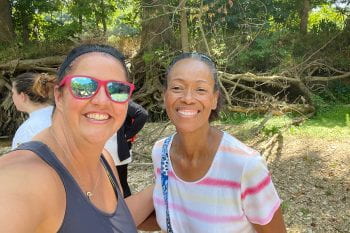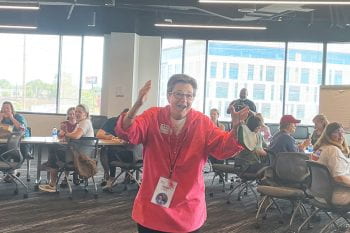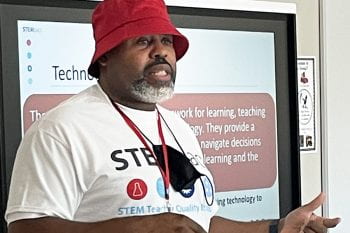Science teacher Jaime Schneider has earned a reputation for herself.
Students come to her class expecting something phenomenal, and she’s happy to deliver. Where else in the building can a seventh grader get a chance to set methane bubbles on fire or generate mystic-looking fog with dry ice and a bucket?
“I always start with a phenomenon,” says Schneider, who counts on the wow factor of science to activate student curiosity into data-driven observation. “We try to define what’s happening. What are we doing? Why is a reaction happening? It’s a great way for students to see themselves as scientists for the first time. They love it!”
Schneider launched the first few days of the school year with the dry ice experiment, a sure-fire crowd pleaser she’s had in her teaching arsenal since attending her first STEM Teacher Quality (TQ) Summer Institute, back in 2012. Her experience as part of STEMpact’s first STEM TQ cohort was impactful enough to draw Schneider back for more in 2022.
She was excited to bring a handful of colleagues from her school district in Belleville, Illinois, for two weeks of nonstop, immersive STEM professional development that has only gotten better over time. Action-packed field trips to some of the region’s STEM-rich locations–Castlewood State Park, Victory Lanes Raceway, MasterCard, MilliporeSigma and the Saint Louis Zoo, to name a few–are guided learning experiences that STEM TQ has become known for since its inception.

“These incredible experiences were just as exciting the second time around,” says Schneider. “Making connections with like-minded teachers from other districts was wonderful, and it has also opened up opportunities to connect with teachers from my own district in a deeper way.”
For Schneider, the other noticeable, welcome evolution in STEM TQ’s approach has been the fixed, collective gaze on diversity and equity.
“I couldn’t get enough of that,” says Schneider. “STEMpact really upped their game on this. Having such diversity among the professionals who came to speak to us changes your thinking. These discussions are essential, and I don’t think we would have been ready for them ten years ago. A lot has changed since then.”
What a difference ten years makes
With its tenth STEM TQ Cohort launched, the STEMpact team prepares for another year of continued effort to address one of the region’s persistent challenges, an insufficient pool of STEM talent to meet the growing demand in Missouri and Illinois, where three of four fastest growing occupations are in STEM fields.

Founded with the belief that education is key to meeting the growing STEM demand, STEMpact is an innovative and proven program designed to equip teachers to inspire and prepare students for STEM success. Its unique, collaborative approach combines the resources and human capital of major corporations and foundations, local schools and districts, and Washington University in St. Louis.
Since 2011, STEM TQ Institute has reached 1,071+ teachers, impacting 35,000+ students.
Deborah Holmes, STEMpact’s project manager and facilitator, has been involved from the start.
“One of the things that has been wonderful to have confirmed through surveys has been the staying power of our initial concepts–STEM is everywhere and the value of “STEMitizing” curriculum,” says Holmes. “In the beginning, there were districts who assigned people to participate. Now, most of our teachers join because they want to be there. There are lots of career connections being made, and the feedback we get year after year continues to be encouraging. We’ve had teachers tell us, ‘You’ve re-energized me.’ and ‘I need this to sustain my career.’” Hear what TQ Institute attendees had to say about the experience on the last day.
Orlando Sharpe, a STEM TQ facilitator for nine years and counting, says that teachers are coming to the experience with a different, more nuanced set of expectations.
“Early on, when STEMpact was formed, and STEM TQ started, STEM itself was still really new,” Sharpe says. “Those conversations were happening at high levels, but not in the classroom. A lot of educators didn’t even know what the acronym stood for. Now, cohorts are coming in with a pretty good sense of what STEM is, and an understanding of why it’s important to prioritize in the classroom.”

Both Holmes and Sharpe agree the equity lens is essential to any work that aims to even the playing field for all schools, all educators, all students.
“Ten years ago, we got a lot of pushback on the cultural competency lens, but in the last five years, that has shifted dramatically,” adds Holmes. “That’s been a really powerful, and necessary change.”
Sharpe focuses much of his energy on the technology components of STEM TQ. He says to assume that all teachers in the region have equal access to technology is a mistake. Many only have access to district-issued devices, and as a result, take fewer chances exploring and downloading apps and other resources that would benefit their classrooms. These teachers are less likely to be familiar with standards for incorporating technology into the curriculum.
“Technology is no longer special,” says Sharpe. “It’s an everyday tool, a reality. We want teachers to see the value of investing in their personal learning of the tools, but also how to integrate those tools for learning. Most educators have become accustomed to finding workarounds rather than just having the resources they need from the start. On one hand, that does lead to creativity by necessity, but it also generates anxiety that doesn’t need to be there.”
Those essential messages about equity in education are consistently thread throughout the 100+ hours of professional development that each STEM TQ participant receives during the summer institute and the monthly sessions held throughout the school year. In Summer 2022, 55+ teachers and facilitators alike were reminded of their superhero status with an inspiring welcome message from STEMpact founding member Deborah Patterson. Two weeks later, the newly STEMitized TQ participants were sent home with an affirming challenge from STEM TQ alumnus and area STEM educator Curtis O’Dwyer.
“The thing we need now more than ever is people in education who are willing to innovate.” O’Dwyer said. “Why just survive, when we can thrive?”
STEMpact is managed by The Institute for School Partnership at Washington University in St. Louis (ISP).